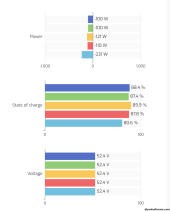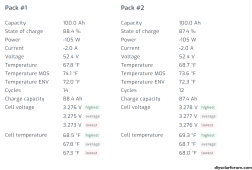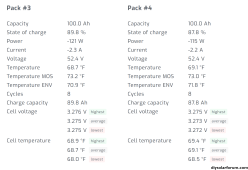42OhmsPA
What's in a title?
What are the highest cell voltages for the batteries?
When, where? What do you think I should I be looking for?What are the highest cell voltages for the batteries?
Tell me why I'm wrong, but I'm thinking this is just a difference in the way each battery BMS is working and communicating with the others and possibly the inverter. The four all seem to be working/acting similarly while the other one (formerly #3, now #5) is working/acting differently.
I'm just shaking my head going WTF?
Nothing appears to be 'broken' just not all operating the same which could be a problem if one or more are operating _enough_ differently....
Hence my bus bar commentNothing appears to be 'broken' just not all operating the same which could be a problem if one or more are operating _enough_ differently....
Thanks. Yeah I don't know that this is having any effect on overall operation.... I only noticed because I had that earlier Undervoltage Error on battery #2 which got my thinking that I really need to fully charge all five batteries and discharge and got through a few cycles to try and equalize/stabilize the operation. (this is still a relatively new system just over a month old and the batteries have never been fully cycled together).I doubt they are operating differently, except in response to different applied voltages. Probably just measuring parameters differently.
Parallel batteries?
The only thing BMS can do is open or close its "switch".
Division of current is determined by resistance, internal plus your external connections.
BMS has its voltage measurements and its current measurements, which have error and offset. So each could measure charge vs. discharge current differently and think SoC is walking up or down, until reset to 100% at some voltage.
A shunt is a resistor, maybe just copper PCB trace (which varies with temperature.) Op-amp sensing voltage has offset, although some are "chopper" and very low offset and drift. But errors accumulate.
Hopefully that has no actual impact on operation, and differences in SoC catch up to each other at the upper and lower knees.
Understand. After I physically moved the 'suspect' battery the behavior followed it so I'm thinking there isn't a cable/resistance/connection issue.Hence my bus bar comment
Apparently it was just one cell in battery #2 and once it was 'fully charged' it hasn't shown any signs of problems in/between the cells... And it did happen when the battery (all the batteries) were pretty low after several days of low/no sun.Undervoltage of entire battery #2? Or undervoltage of one cell?
They're all going to be near the same battery voltage, unless high resistance to some (could be internal).
If a cell is actually low voltage (try to confirm with DMM), must be either unbalanced or near battery near empty and that cells is the "runner". Or high cell IR, or bad connections.
The soc is computed from the cell voltages, that's why I keep asking about them. Everything should stay close until they get above 3.4v.When, where? What do you think I should I be looking for?
Right now #5 is 3.316 High , 3.315 average, 3.314 low
I'm not sure what I should be looking/watching for.
As I was watching them approaching 100 % soc they were all close no discrepencies as with the "UV" error before (on #2)
I wasn't watching the cell voltages with the charging stopped. I was out on my walk...
Right now the inverter is drawing exclusively from #5 (formerly #3) ... I'm watching to see if the others come in as it reaches their same SOC.
(I know you don't care for SOC etc. but that's where I'm seeing the deviation/difference in these batteries/packs)
Apparently it was just one cell in battery #2 and once it was 'fully charged' it hasn't shown any signs of problems in/between the cells... And it did happen when the battery (all the batteries) were pretty low after several days of low/no sun.
Thank you I appreciate all the help....still trying to wrap my head around all this and understand why the difference in behavior of the one outlier battery which on recent inspection seems to be more in line since the "full" charge to 100%... Maybe that's what we need here is a few full cycles.The soc is computed from the cell voltages, that's why I keep asking about them. Everything should stay close until they get above 3.4v.
I can see all the cell voltages at once if I connect a computer to the battery string but have to disconnect the inverter communication when I do.Can you get a reading of all the cell voltages?
Could be that one cell is at lower SoC, so limits total Ah you can draw from battery because it its lower voltage limit while others still have unused capacity.
If that is the case, holding battery within voltage range that allows balancing could fix it (after eternity, slow passive balancing by bleeding off all others. Active charging of one cell could fix. But don't know why low in the first place, if it actually is.)
Or, maybe you had drained all the batteries close to 0% SoC. There will always be one cell that is the weakest, no matter how close their capacity is.
Can you determine what DoD they were at?


See my post just now with battery 5 breaker turned on and off...(all other batteries on in both images).Something about that battery is different, no idea what but I would not obsess about it but keep an eye on it.
Well those were interesting but far from enlightening. Oh well...In the mean time I think it's 'to school' time so that I better understand BMS and these batteries and inverters. Generally if I can understand the theory and the reasoning behind a system I can take that down to the details (at least in understanding and managing it)
So: https://www.einfochips.com/blog/und...s-how-it-works-building-blocks-and-functions/
and https://www.synopsys.com/glossary/what-is-a-battery-management-system.html




All your voltages are the same. It's fineWell those were interesting but far from enlightening. Oh well...
Currently:
View attachment 181825View attachment 181828View attachment 181829View attachment 181830
I'd bet the 3.269V cell in pack 5 is what's dragging the soc down.Well those were interesting but far from enlightening. Oh well...
Currently:
View attachment 181825View attachment 181828View attachment 181829View attachment 181830


